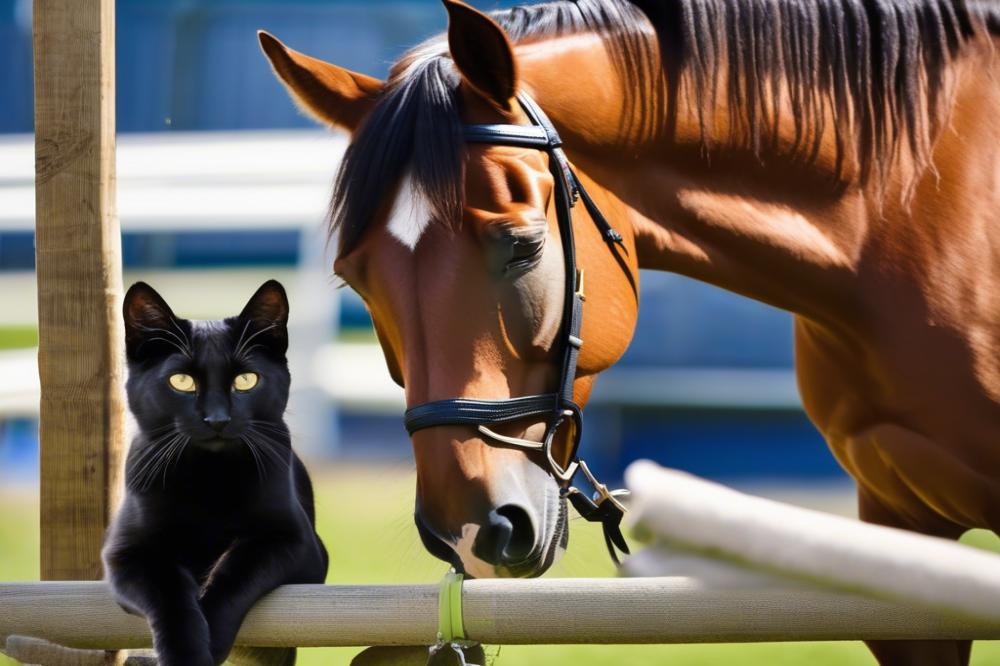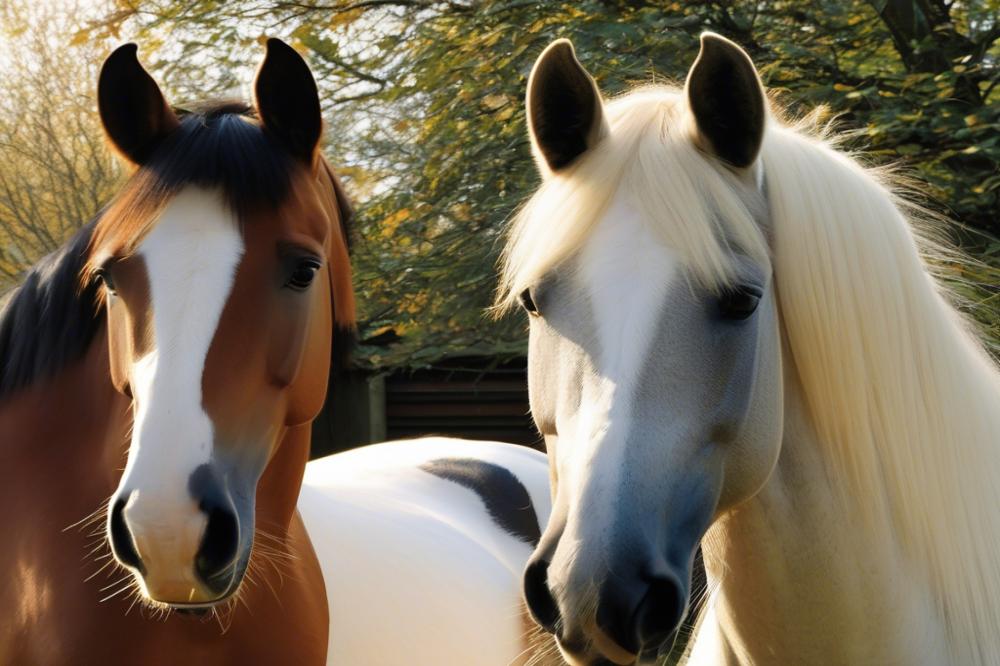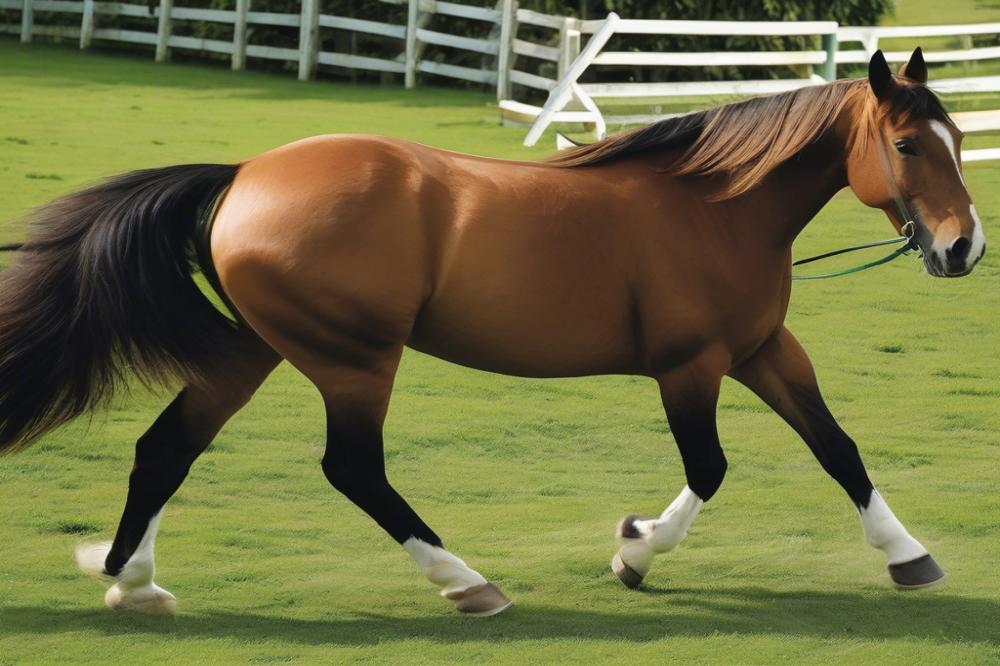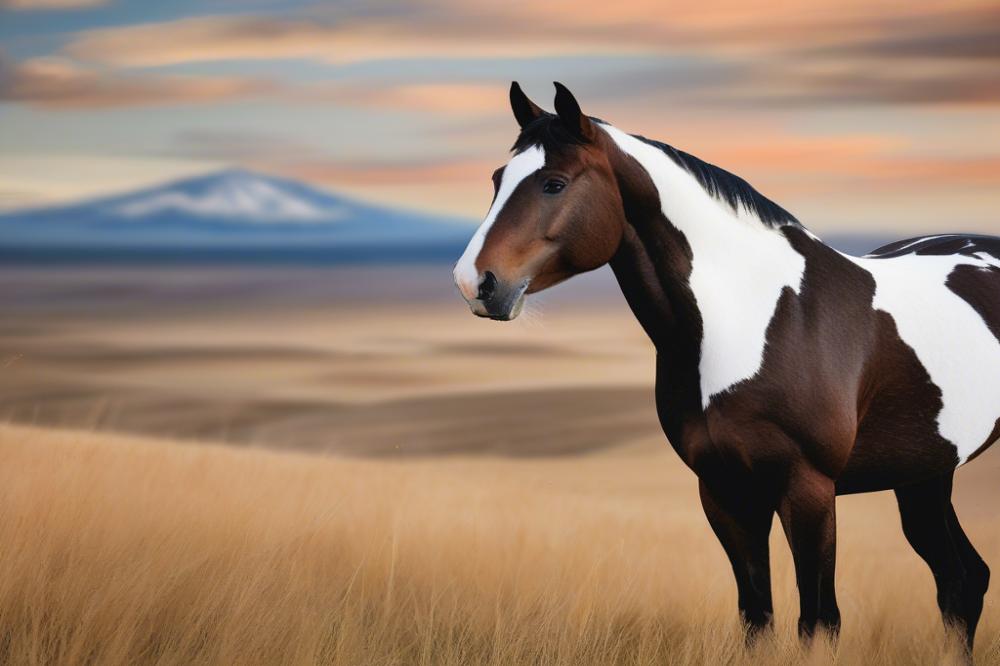Understanding Animal Dynamics
Have you ever watched a cat casually stroll through a barn, while a well-groomed buckskin horse gives it a sideways glance? It’s an intriguing scene that invites the question: do these two types of animals get along? While both species have their unique quirks and personalities, their interactions can be fascinating to observe. Animals, just like us, have their favorites and their not-so-favorites. Some cats might see a horse as a giant playmate, while a horse may be indifferent or even cautious.
Why Animal Interactions Matter
Delving into the relationship between different animals can shed light on their behaviors and feelings. Understanding how cats and horses interact is particularly important for those living in multi-pet households. Every creature has its own way of interpreting the world, and their feelings about one another can impact everyday life. A horse might become anxious or unfocused if it feels threatened by a sneaky feline. Likewise, a cat could react defensively if a horse approaches but doesn’t quite grasp its size. Recognizing these dynamics contributes to healthier animal cohabitation.
The Aim of Our Discussion
This article will explore the fascinating world of equine and feline interactions, particularly when introducing cats to horses. By unpacking horse behavior alongside cat behavior, we hope to provide insights for pet owners navigating this delicate relationship. Whether you’re considering adding a new pet to the mix or just curious about how these animals vibe together, you’ll find valuable information here. It’s essential to approach these relationships with care to avoid stress for all involved. Remember, a selenium deficiency horse can have its own set of issues that might make it more sensitive to new friendships!
With a mix of observations, guidelines, and maybe even a story or two, let’s trot along this path together. Who knows? It might just inspire you to watch your animals in a new light!
Horses and Cats: Natural Behaviors

Overview of Horse Behavior and Social Structures
Horses are social animals. They thrive in groups and have a clear hierarchy. They often form strong bonds with other horses. Their language is rich with body movements and sounds. For example, a tail swish might mean they are annoyed. When they graze, it’s a social activity too. They often stand side by side, munching away. This bonding helps in reducing their stress levels.
Understanding horse behavior is crucial when thinking about animal cohabitation. Horses can be curious and sometimes cautious. Introducing cats to horses should be done carefully. One sudden movement can make a horse spook. That could lead to a chain reaction of fear. Keeping interactions calm is the key.
Overview of Cat Behavior and Social Structures
Cats, on the other hand, have a reputation for being more independent. Their social structures are often based on territory and resource availability. They may not need as much social interaction as horses do. Often, you’ll find them napping in sunspots, guarding their turf. Grooming is a big part of cat behavior. This ritual helps them bond with others they trust.
Contrary to popular belief, some cats enjoy companionship while others might be lone wolves. When you think about horse and cat compatibility, remember it varies widely. Some cats may decide a horse is just another large, curious creature. Others may see it as a threat. A gentle introduction is always a good idea.
Analysis of How These Behaviors Influence Interactions
Both animals have very different ways of communicating. Horses may rely on body language, while cats use vocalizations and subtle gestures. Because of this, misunderstandings can easily arise. For instance, a horse might misinterpret a cat’s sudden darting movement as a threat. Simultaneously, a cat might become startled by a horse’s large size or unexpected noise.
Successful interactions require patience and awareness. Multi-pet households can be wonderful but may also present challenges. Providing safe spaces for each pet is vital. Horses need their own area to roam. Meanwhile, cats often prefer cozy spots to retreat. It’s fascinating to watch their dynamics evolve upon gradual interaction.
Every animal holds its own quirks. When you see a cat strutting confidently around a horse, it’s usually entertaining. The horse may raise an eyebrow but seems intrigued too. However, keeping things slow fosters trust. Relationships between these two species can be both amusing and rewarding.
Navigating the cohabitation of these animals requires understanding. Monitor their interactions closely, as comfort levels vary. By respecting their behavior patterns, your pets might just become best buddies. In the end, patience goes a long way in fostering harmony in your home.
Common Interactions Between Horses and Cats

Horses and cats share some intriguing interactions, especially in places like farms and stables. On these grounds, you can often find both animals roaming around, curious about each other. The horse and cat compatibility can sometimes surprise owners. Cats are known for their playful energy, and horses exhibit a calm curiosity. Many people enjoy watching these two species navigate their environments.
Types of Interactions Observed
Daily life often brings about signposts of animal cohabitation. For instance, a cat might weave through a horse’s legs, teasing the larger animal just enough to provoke a gentle nudge. Such scenarios highlight their playful yet cautious natures. Horses tend to be curious creatures. If they catch sight of a feline, they may approach slowly, their large eyes full of wonder. Cats, in turn, don’t shy away. They often venture near, especially if they think there’s something intriguing to discover.
Farms and Stables With Horses and Cats
A typical farm can resemble a lively circus, with horses munching hay and cats lazily sunning themselves nearby. In stables, you might see a horse lifting its head from the feed bucket to observe a cat perched on a nearby beam. Cats often view these large animals as gentle giants. Their daring hearts can lead them to play tag, running circles around a confused horse. Each moment captures a unique blend of caution and curiosity.
Behavioral Examples: Curiosity and Playfulness
Take a moment to imagine an afternoon at a barn. A horse stands patiently, while a cat stalks playfully through the grass. One might even leap out in a surprise, causing the horse to snort in confusion. This interaction offers a great insight into horse behavior and cat behavior. Both animals demonstrate a mix of respect and intrigue. Horses are generally gentle giants; their reactions to cats can range from indifference to genuine interest.
It’s fascinating to see how cats often test boundaries. They might sneak closer to a horse, flicking their tails as if daring the giant to step closer. In contrast, a horse may gently nudge a cat with its nose. This shows a calm acceptance of the feline’s presence. Playfulness is in both their natures. Even in multi-pet households, keeping an eye on these interactions is essential. Sometimes, things can get a bit rowdy, but most of the time, it’s harmless fun.
Stories of horses and their feline friends are not just cute; they represent a broader picture of companionship. Owners who have both in their lives often share spontaneous adventures unfolding in their backyards. This unique relationship encourages us to reflect on the bond between different species. After all, who would have thought that horses and cats could strike up such a friendship?
Factors Influencing the Relationship

The individual personalities of horses and cats play a big role in how well these two get along. Just like people, animals have unique traits. A friendly horse might welcome a curious cat with open hooves. In contrast, a nervous horse could see a cat as a frightening creature. Sometimes, a timid cat can be scared of the larger animal, too.
Past experiences can also shape how they view each other. If a horse had a negative encounter with a cat before, it may be skeptical. On the flip side, a cat that has no fear of horses can be quite bold. Animal cohabitation often reflects attitudes shaped by earlier events. A history of calm and happy interactions fosters better relationships.
The environment and available space greatly influence their compatibility. A large, open pasture tends to be perfect for both pets. Horses can roam freely, while cats can sneak around as they please. In cramped spaces, however, things can get tense. Multi-pet households with limited room may spell trouble.
Health and well-being also matter in this equation. A horse dealing with stress may be less tolerant of a cat’s antics. Conversely, a healthy, happy cat feels more confident to explore. When introducing cats to horses, the state of each animal is crucial. Warm and inviting surroundings encourage positive interactions.
Keep in mind that introducing these animals should be done cautiously. Supervised interactions allow for careful observations. When one animal shows discomfort, it’s wise to give them space. Too much excitement can lead to misunderstandings. That’s when both animals might need a little distance.
Case Studies and Anecdotal Evidence
Many pet owners have shared their stories about horses and cats living together. These tales often highlight how animal cohabitation can lead to unexpected friendships. One owner described how their horse and cat became best buddies, playing together in the pasture. The horse would lift its head, and the cat would leap onto its neck, purring happily.
Positive interactions can happen, even when introducing cats to horses. A gentle touch and a little patience can go a long way. Sometimes, a cat will approach a horse as if it’s just another big, furry friend. This confidence can spark a bond. Horses, with their curious nature, seem to enjoy the company of a playful cat, making them feel less lonely in the stable.
For multi-pet households, observing horse behavior is essential. It helps to understand how animals react to one another. From time to time, a horse might snort or stamp a hoof in surprise at a cat’s antics. That initial shock can lead to amusing moments. Some owners chuckle as they watch their horse jump back from a sudden pounce!
However, challenges do arise in this mixed environment. Not every horse welcomes the presence of a cat. Some might be startled by fast motions or sudden noises. A frightened horse could kick or push away a curious feline, leading to unsafe situations. Therefore, monitoring their interactions is crucial to maintain harmony.
There are reports of cats that take on a caretaker role. One story tells of a cat curling up beside a resting horse, providing comfort. That kind of companionship demonstrates the potential for harmony and affection. Yet, not every cat will find that blissful fit. Individual personalities matter. Some cats prefer to keep their distance, maintaining their independence over any budding friendship.
Each pet brings its own unique quirks to the mix. Cat behavior can range from aloof to endlessly curious. A daring cat may boldly approach a horse while another prefers to observe from afar. The bond they develop really depends on their individual temperaments. All in all, there’s a lot to discover when animals share the same space.
Pet owners often report mixed results in their experiences. These stories reveal a rich tapestry of outcomes. Some owners have laughed at the silliness, while others have faced tension. Understanding the dynamics of horse and cat compatibility can help make their living situation a beneficial one.
Potential Benefits of Horses and Cats Together
Psychological Advantages for Horses and Cats
It’s fascinating how animals can build relationships. Horses often seem to enjoy the company of smaller animals, including cats. When a cat wanders into a horse’s space, it can spark curiosity. This interaction may help reduce boredom for both pets. Feeling less lonely can enhance their happiness. Cats, on the other hand, are independent creatures. Their playful antics might be amusing for horses to watch. Engaging with a cat could relieve stress for a horse during challenging times.
Impact on Companionship and Emotional Well-being
Animals thrive on connection, just like humans. Companionship from another species can create a sense of balance. Often, you will find a cat curled up near a horse, soaking in warmth. This scenario promotes an atmosphere of calmness in stables. With a little patience in introducing cats to horses, both animals can enjoy great emotional support. Feeling secure can encourage better horse behavior. A happy horse is more likely to be a healthy one.
Role in Managing Pests and Providing Comfort
Cats are natural hunters. They can help keep the area around stables free of pests. A skilled cat will catch mice, which is beneficial for livestock. This teamwork fosters a practical reason for animal cohabitation. Additionally, horses may find comfort in having a cat close by. The presence of a feline can make an environment more lively. Owners of multi-pet households often notice smoother interactions as the bond strengthens over time. Although they are different, horse and cat compatibility can grow remarkably well with the right approach.
Best Practices for Introducing Horses and Cats
Guidelines for Safe Introductions
Introducing cats to horses requires careful planning. First, pick a neutral space for their first meeting. This helps both animals feel less territorial. Keep the horse on a lead rope. This way, you’ll have more control over the situation. Similarly, it’s best to confine your cat in a carrier or a safe room. This prevents any unexpected movements.
Open doors slowly. Give each animal a chance to sniff and observe. Let them see and hear one another without too much pressure. It’s like giving them a sneak peek before the grand show. Patience is key. You might feel eager for them to become pals, but rushing can backfire. Remember, good horse and cat compatibility takes time.
Monitoring Behavior During Initial Meetings
Watch both animals closely. Notice their body language. A horse that’s relaxed will have its head low, while a cat may be curious if its tail is up. Watch for signs of stress too. If the cat hisses or the horse prances too much, it might be time to step back. Responding to their behavior shows you care about their feelings.
You might also notice your horse trying to ignore the cat. That’s just their way of saying, “I’m too cool for this.” Keep these encounters short at first. A few minutes is a good start. Gradually increase the time they spend together as they grow more comfortable. Always end on a positive note to keep their first experiences pleasant.
Creating a Harmonious Living Environment
Setting up a space that works for all pets is essential. Create separate areas for eating and resting. Cats love high perches, so consider adding a shelf or two. Horses appreciate their own space. Ensure they have room to roam without feeling crowded. A little bit of space goes a long way in animal cohabitation.
Consider their daily routines too. Cats are often most active at dawn and dusk. Horses, on the other hand, have a different rhythm. It’s smart to allow these schedules to coexist without too much interference. Offer plenty of toys for the cats and safe enrichment for the horse. Boredom can lead to unwanted behaviors. Keeping everybody entertained helps maintain peace!
Interacting with both animals regularly helps strengthen their bond. Talk, play, and, when possible, include them in your activities. Sharing experiences can lead to friendship. After all, who wouldn’t want to see a horse and a cat sharing a patch of sunshine together? Making adjustments as needed shows you’re committed to making this work.
Remember, every animal has its personality. The journey might take twists and turns, but with patience and care, you’ll create a happy home for your multi-pet households. Have fun and embrace the uniqueness of each animal’s character. Good luck!
Wrapping It Up
As we look back over what we’ve discussed, it’s clear that the relationships between equines and felines can be quite fascinating. While some might imagine a frenzied chase like you see in cartoons, that’s not the usual story. Many horses seem to hold a curious tolerance for cats, while the latter often view the former as potential friends—or at least interesting figures worth investigating. Observing these interactions can reveal much about their personalities, showcasing how animals can coexist peacefully, even if they are from different worlds.
Looking deeper, it’s worth noting how horses, especially certain dressage horse breeds, might be more relaxed around their furry neighbors. Those graceful creatures have a natural poise, allowing them to accept the antics of a playful cat with a measured attitude. Cats, with their curious and sometimes mischievous nature, often bring a dose of entertainment to the pastoral setting. Even if they sometimes push their luck a bit, the outcome is usually harmless. It’s a little like watching a game of tag, where the stakes are lower, but the fun is immense!
It’s essential for horse owners and cat lovers alike to cherish these moments. Every interaction—whether a gentle nuzzle from a horse or a quick dart from a cat—tells a story. Just picture a horse’s soft whinny as a cat approaches, tail in the air, fully confident in its superior cuteness. The shared space they inhabit is rich with lessons in compatibility and calmness.
If you have pets, why not observe their social dramas? You might just discover something delightful. Maybe your own horse will showcase bravery in front of a tiny feline friend or perhaps a tough-looking kitty will end up lounging on the mane of a gentle giant. These small interactions remind us of nature’s humor and the intricate webs of companionship that tie our animal friends together.
Isn’t it comforting to think about how animals navigate their world? Just like checking a horse human age chart helps us understand our equine friends better, observing their relationships can broaden our understanding of animal behavior. Why not catch a moment in action? Make a cup of tea, sit back, and enjoy the show; you never know what you might learn!



